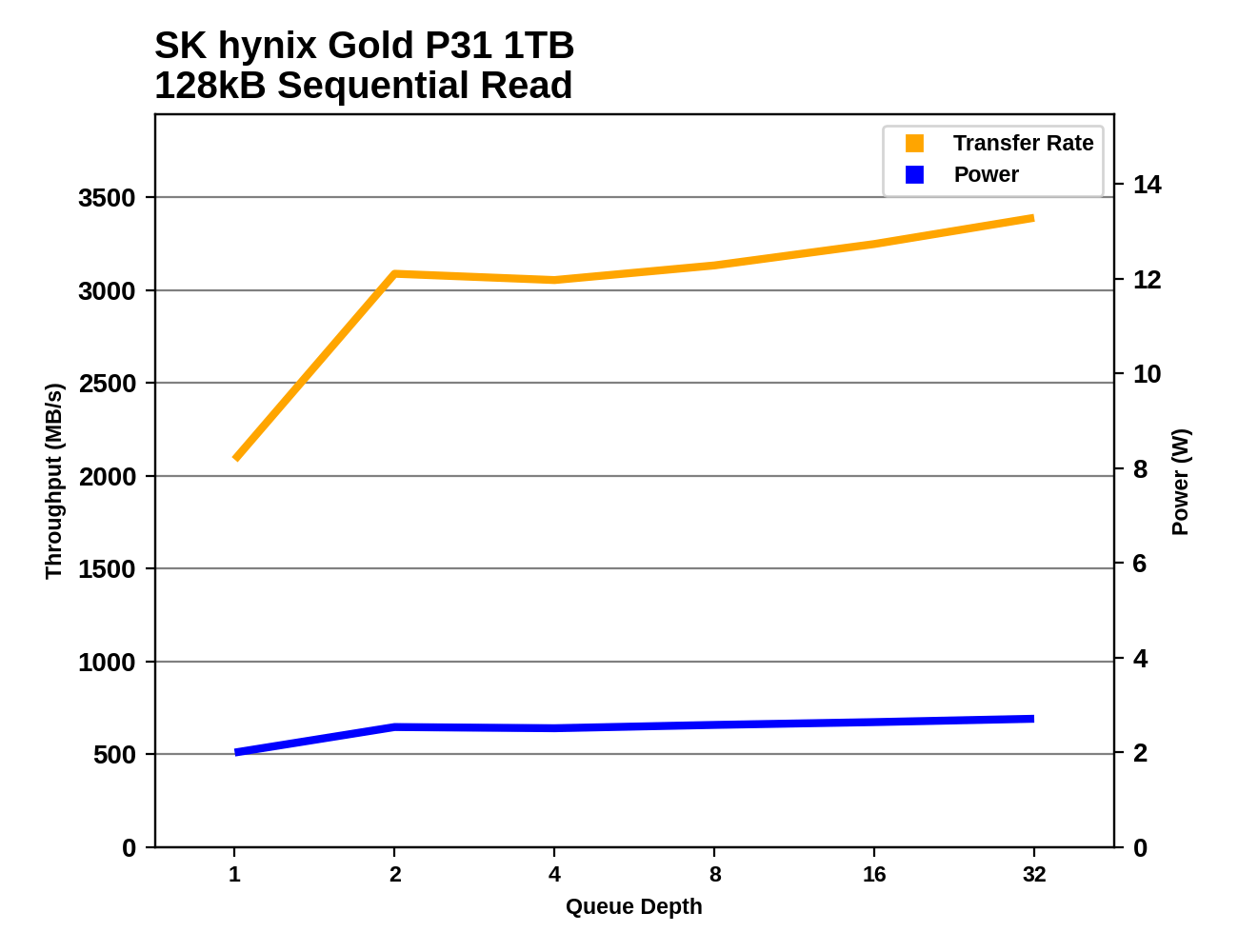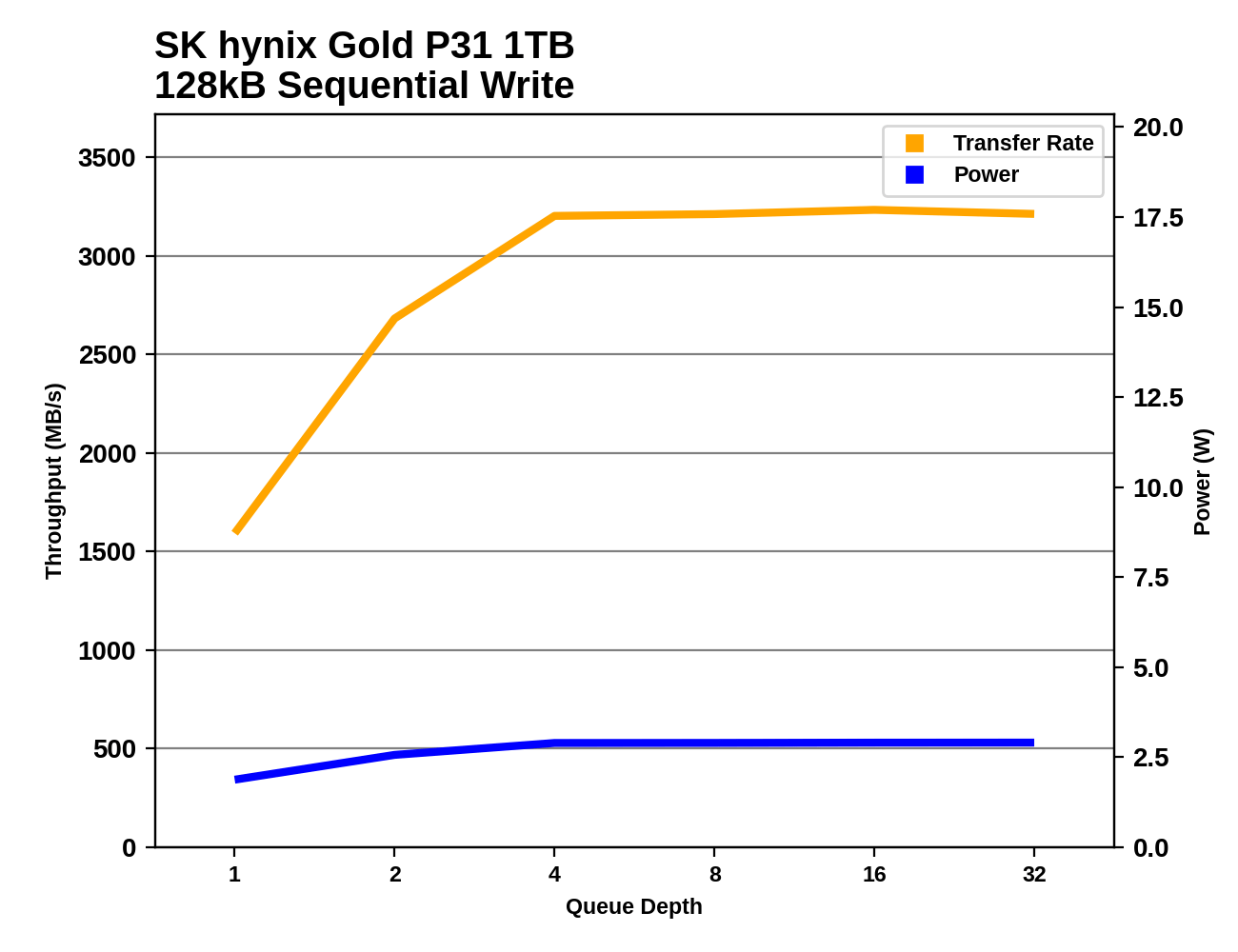The Best NVMe SSD for Laptops and Notebooks: SK hynix Gold P31 1TB SSD Reviewed
by Billy Tallis on August 27, 2020 8:00 AM ESTSequential Read Performance
Our first test of sequential read performance uses short bursts of 128MB, issued as 128kB operations with no queuing. The test averages performance across eight bursts for a total of 1GB of data transferred from a drive containing 16GB of data. Between each burst the drive is given enough idle time to keep the overall duty cycle at 20%.

The burst sequential read performance from the SK hynix Gold P31 is very good, but not quite fast enough to beat the drives based on the Silicon Motion SM2262EN controller.
Our test of sustained sequential reads uses queue depths from 1 to 32, with the performance and power scores computed as the average of QD1, QD2 and QD4. Each queue depth is tested for up to one minute or 32GB transferred, from a drive containing 64GB of data. This test is run twice: once with the drive prepared by sequentially writing the test data, and again after the random write test has mixed things up, causing fragmentation inside the SSD that isn't visible to the OS. These two scores represent the two extremes of how the drive would perform under real-world usage, where wear leveling and modifications to some existing data will create some internal fragmentation that degrades performance, but usually not to the extent shown here.

On the longer sequential read test that involves some slightly higher queue depths, the Gold P31 is basically tied for first place when reading data that was written sequentially. When reading data that has previously been fragmented by the random write test, the P31's performance is considerably higher than the other flash-based SSDs and closer to the Optane 905P.
 |
|||||||||
| Power Efficiency in MB/s/W | Average Power in W | ||||||||
In absolute terms, the power consumption of the Gold P31 isn't drastically lower than some of the other fairly efficient high-end NVMe drives like the WD Black SN750. But once performance is taken into account, the Gold P31's efficiency stands far above the competition.
 |
|||||||||
The SK hynix Gold P31 doesn't need high queue depths to deliver good sequential read throughput: at QD2 it's already above 3 GB/s, but there are further slight performance increases from higher queue depths. That performance profile is very similar to the Samsung 970 EVO Plus, but that drive requires about twice the power that the P31 uses.
Even at QD1, the sequential read performance from the Gold P31 is above the ~2GB/s limit of most other four-channel NVMe drives we've tested (with eg. Silicon Motion SM2263 based controllers). That leaves it entirely in a performance range where all the competitors are 8-channel drives that don't come close to matching power efficiency of the Gold P31.
Sequential Write Performance
Our test of sequential write burst performance is structured identically to the sequential read burst performance test save for the direction of the data transfer. Each burst writes 128MB as 128kB operations issued at QD1, for a total of 1GB of data written to a drive containing 16GB of data.

The SK hynix Gold P31 has fairly ordinary burst sequential write performance by high-end NVMe standards: tied with the SM2262EN-based ATATA SX8200 Pro but beat by the Phison-based Seagate drives.
Our test of sustained sequential writes is structured identically to our sustained sequential read test, save for the direction of the data transfers. Queue depths range from 1 to 32 and each queue depth is tested for up to one minute or 32GB, followed by up to one minute of idle time for the drive to cool off and perform garbage collection. The test is confined to a 64GB span of the drive.

On the longer sequential write test that brings in higher queue depths, the Gold P31 is tied for second place, while the Phison E16 based Seagate drive (built for PCIe 4 speeds, but limited by this testbed to PCIe 3 speeds) unsurprisingly takes first place.
 |
|||||||||
| Power Efficiency in MB/s/W | Average Power in W | ||||||||
At this point, the record-shattering power efficiency scores from the SK hynix Gold P31 are no longer a surprise. The overall fastest drive has the second best efficiency score (56% the performance per Watt of the P31) and the next two most efficient drives are much slower NVMe drives from Toshiba/Kioxia.
 |
|||||||||
The Gold P31 doesn't reach its full sequential write speed until QD4, while several of its competitors saturate at QD2. However, once the P31 is at full speed, it has one of the best sustained write speeds, and shows no sign of its SLC cache running out at any point during the test. Power consumption is comparable to the slowest NVMe drive that can barely hit half the throughput of the Gold P31.
Similar to the sequential read results, the P31 starts out at QD1 with high performance that almost puts it beyond what other 4-channel NVMe drives can do at any queue depth. From there, the P31 continues to redefine what's possible with an increasingly wide lead in power consumption relative to all other high-end drives we've tested.












80 Comments
View All Comments
jaydee - Tuesday, September 1, 2020 - link
Thanks Billy! Reading the part about the power efficiency though, any thoughts of quantifying the extra battery life you could expect to see (typical laptop) from the SK Hynix Gold P31 over a Phison E12? The numbers look impressive on paper in terms of percentages against other HDs, but what are we talking about? An extra.. 5/10/15/20 minutes under an extreme R/W heavy workload? What about an average R/W workload? For sure the price/performance is there too so it appears a good buy anyway, I just don't know what to make of the efficiency numbers in terms of actual computing experience.Jimster480 - Saturday, September 5, 2020 - link
I just put this into my new Ryzen 4600H Powered Nitro 5 and it beats my EX920 in everything! Really a leap in performance and power consumption that wasn't expected from SK Hynix that has been an Also-ran until now!rlr297 - Wednesday, September 23, 2020 - link
Is there an update on when the platinum drives will be released? I am looking for a 2TB variant. If not, do you have a 2TB drive you'd recommend for a laptop?MatthiasM - Tuesday, November 10, 2020 - link
Hi All: Can I please ask for collective wisdom? I was very impressed by the review of this drive, especially the low power consumption for laptops. So, I bought one for my 2017 MacBook Air. This can use NVME drive with a Sintech Adapter, no problem. Several other NVME drive (WD, ADTA) run without problems. But when I built in this SK Hynix drive, it wouldn't start. It initiates the boot process, but won't complete it. But when I insert the drive in an external enclosure, it starts from it as boot drive, no problem. Only when it is internal, it won't start. Any suggestions? NVME controller incompatible with MacBook? Any ideas on how to fix this?oRAirwolf - Monday, November 30, 2020 - link
A little late to the fold, but there was a comment about drive software and firmware updates. SK Hynix released a tool for this drive called Drive Manager: Easy Kit. It's available at the very bottom of this page: https://ssd.skhynix.com/GoldP31.htmlEarFull - Sunday, February 7, 2021 - link
Totally over my head, I bought one of these off Amazon after finding out Hynix supplies OEM SSD's for Apple laptops. Thought I'd play with it as a peripheral plug in. Problem is, I can't find an external enclosure that is appropriate for it. I wrote Hynix and they commented it is only for INTERNAL use. Does anyone KNOW of an external enclosure suitable for this 1TB Hynix P31 Gold Drive? I don't care now if it is USB or Thunderbolt. Thank you.EarFull - Sunday, February 7, 2021 - link
Tried the Hynix P31 Gold NVME in the OWC Envoy Express: did not work. Now OWC site states in this configuration only available for Windows 10. Bummer.EarFull - Thursday, February 11, 2021 - link
Posted a comment two days ago and can't find it. To reiterate: bought Hynix P31Gold NVME to use as external drive. OWC Envoy Express will NOT work in this configuration on macOS. So, bought this SSK Aluminum M.2 NVME SSD Enclosure Adapter, USB 3.1 Gen 2 (10 Gbps) to NVME PCI-E M-Key Solid State Drive External Enclosure (Fits only NVMe PCIe 2242/2260/2280) to try. Indeed, it works perfectly for about $20. The enclosure is well made, metal, and comes with extra NVME 'screws' and such and two cabes for USB-C to USB-C as well as USB-C to USB-A. Hope this helps. PatrickDavidm771 - Friday, November 26, 2021 - link
Anyone know how the P31 Gold compares in terms of power efficiency against an SN730 OEM nvme drive? Read the specs of the SN730 and the power states are really low mostly except the PS1+2 numbers are better on the P31 Gold. Thankssrahman5317 - Friday, January 21, 2022 - link
Thank you so much guys. This was perfect and exactly the kind of reporting I was looking for. Much love from a laptop user